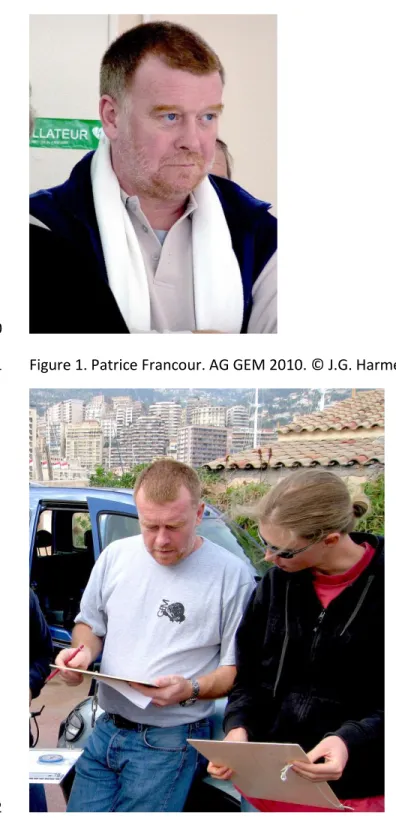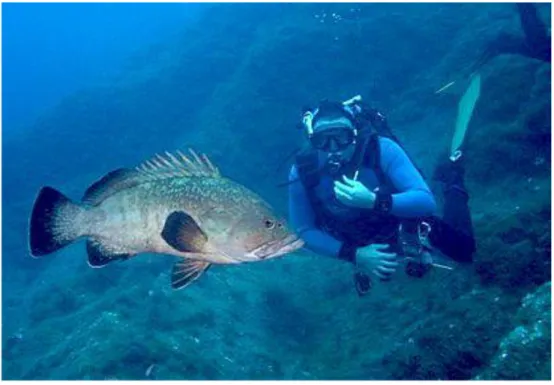HAL Id: hal-02964955
https://hal-amu.archives-ouvertes.fr/hal-02964955
Submitted on 8 Mar 2021HAL is a multi-disciplinary open access archive for the deposit and dissemination of sci-entific research documents, whether they are pub-lished or not. The documents may come from teaching and research institutions in France or abroad, or from public or private research centers.
L’archive ouverte pluridisciplinaire HAL, est destinée au dépôt et à la diffusion de documents scientifiques de niveau recherche, publiés ou non, émanant des établissements d’enseignement et de recherche français ou étrangers, des laboratoires publics ou privés.
In memoriam Professor Patrice Francour
Harmelin-Vivien Mireille, Paolo Guidetti, Virginie Raybaud
To cite this version:
Harmelin-Vivien Mireille, Paolo Guidetti, Virginie Raybaud. In memoriam Professor Patrice Francour. Cybium : Revue Internationale d’Ichtyologie, Paris : Muséum national d’histoire naturelle, 2020, 44 (1), pp.3-4. �10.26028/cybium/2020-441-012�. �hal-02964955�
1 1
In memoriam, Professor Patrice FRANCOUR
2(April 13, 1960 – October 13, 2019)
34
It is with shock and great sadness that we heard of the sudden passing of our distinguished
5
colleague and friend, Professor Patrice Francour, at the age of 59, from pancreatic cancer against
6
which he courageously fought till the end. During his whole life, he worked to protect the seas
7
and the oceans, especially the Mediterranean Sea, which was so dear to him.
8
Born in Paris in 1960, Patrice Francour studied marine biology and ecology at Paris VI
9
University. For his master degree internship (DEA), he went to Marseille in 1984 to study the
10
fauna of the Posidonia oceanica meadows with Prof. C.F. Boudouresque’s team. A few years
11
later (1990), he completed his PhD at the Banyuls-sur-Mer Marine Station, under the dual
12
auspices of Paris VI University and Aix-Marseille II University. His PhD was centered on the
13
study of the dynamics of the Posidonia oceanica ecosystem in the Port-Cros National Park. He
14
focused his research on quantifying the biomass variations of the different compartments of this
15
ecosystem in order to develop the modelling of its trophic functioning. Subsequently
(1994-16
1995), he worked as a postdoctoral researcher at the Portobello Marine Laboratory, in New
17
Zealand, collaborating with Prof. E. Harvey’s Lab.
18
Patrice Francour worked as an active and much appreciated member at the GIS Posidonie in
19
Marseille, until he was first recruited as an Assistant Professor at the University of Nice-Sophia
20
Antipolis in 1998 in the Coastal Marine Environment Laboratory, headed by Prof. A. Meinesz.
21
In addition to teaching ecology at the University, he was also at that time the director of the
22
Natural Sciences Department, Nice IUFM, as he was deeply committed to the training of natural
2
sciences secondary school teachers. After his HDR (habilitation to supervise research) in 1999,
24
he was nominated Full Professor at the University of Nice-Sophia Antipolis in 2002. From 2008
25
to 2015, he was the Director of the ECOMERS Laboratory (a lab specialized in Marine Ecology
26
and Ecotoxicology), then Deputy Director since 2016. He was one of the contributors to the
27
development of this laboratory, now renamed as UMR ECOSEAS (Ecology and COnservation
28
Science for sustainable sEAS), specialized in Marine Socio-Ecology.
29
As a specialist in fish communities in rocky areas and seagrass beds (Posidonia oceanica), his
30
work mainly took place in marine protected areas (especially Port-Cros National Park, Scandola
31
Marine Reserve, Cap Roux-Saint Raphael Fishery Reserve). His research in fundamental marine
32
ecology was chiefly aimed at understanding the structure and dynamics of fish assemblages, the
33
role of biodiversity in ecosystem functioning and the importance of habitat structure. He also 34
contributed to numerous innovative approaches in applied marine ecology research. He 35
significantly contributed to improving the available knowledge on the effects of protection 36
measures on fish communities, the role of management in Mediterranean marine protected areas, 37
the sustainable exploitation of coastal marine resources by small-scale fisheries and the use of 38
artificial reefs for the restoration of local fishing resources. 39
On the strength of his expertise and competences, he was involved in the scientific committees 40
of several marine parks. As a participant and executive board member of the GEM grouper 41
research association (Groupe d’Etude du Mérou), Patrice Francour had a passionate interest in 42
the grouper, these large peaceful fishes, curious and attracted by divers, but severely impacted by 43
humans, quite often locally extirpated because of the impact of recreational and professional 44
fishers. With other scientists, he was committed to the preservation of the emblematic and
over-45
exploited dusky grouper Epinephelus marginatus along the French coasts. As a fish expert, he
3
regularly published new or updated records of fish species reported from France or the
47
Mediterranean basin (Gobiidae, Kyphosidae, Siganidae, Fistulariidae, Oplegnathidae). One part
48
of this activity was devoted to the spread of non-indigenous species of fish in the North-Western
49
Mediterranean. He made a major contribution to the development of expertise to assist marine
50
protected area managers and staff members in assessing the effects of multiple human activities
51
(fishing, anchoring, etc.). Recently, he was also involved in citizen science to encourage
52
members of the public to participate in field monitoring of fish populations.
53
During his scientific career, Patrice Francour authored or co-authored more than 90
54
publications and 9 book chapters on echinoderms, fishes, seagrasses, artificial reefs and fish
55
invasions in the Mediterranean Sea. He supervised more than fifteen PhD students and a large
56
number of master’s degree students. In addition to his teaching activities in biology and ecology,
57
he also undertook a wide range of scientific expert reports for various universities and scientific
58
agencies in France and abroad. In particular, he was since 2006 an active and highly appreciated
59
member of the IUCN Grouper and Wrasse Specialist Group, then too since 2012 of the Snapper,
60
Seabream and Grunt Specialist Group. He was working recently with IUCN colleagues on the 61
preparation of fish species assessments for the IUCN Red List of threatened marine fishes, on 62
both grouper and wrasse and certain other specific fish family groups, and on Mediterranean and 63
Eastern Atlantic marine fishes in general. 64
From New Zealand to the Mediterranean Sea, Patrice especially enjoyed field work, diving 65
with colleagues, observing fishes in nature, studying fish communities, tracking non-indigenous 66
species…while passing pleasant moments in good company. He especially liked challenges. 67
One event in particular in Patrice’s life deserves to be highlighted. In 1988, Patrice Francour
68
narrowly escaped death during a field-trip devoted to the conservation of the monk seal in
4
Mauritania. He was the only survivor of a group of five, when their jeep hit a mine. He showed
70
great courage in recovering from his injuries, but remained profoundly affected by this tragedy.
71
If in that tragic event death let him escape, this has unfortunately not been the case with his
72
recent illness. The void he has left to family, friends and colleagues will remain unbridgeable.
73
But above all, we wish to remember him as he was. Patrice Francour was a researcher 74
motivated by a deeply passionate interest in marine life, he was an excellent underwater diver 75
and photographer, sometimes tempted to dive a little too deep for his diving buddies, attracted by 76
some small cryptic goby, one of his last passions! He dived underwater intensively throughout 77
his life, and again plunged below the surface of the sea for the last time in July 2019, just before
78
the worsening of his illness and his last journey.
79
Colleagues and friends, researchers and divers, students and collaborators will greatly miss 80
him, but we know for certain that anyone who knew him will keep alive the memory of the good 81
times spent together. Our deepest thoughts and sympathy are with his family. 82
Vale, ciao, salut Patrice and rest in peace in the divers’ paradise with your beloved groupers… 83
84
Mireille Harmelin-Vivien, Paolo Guidetti and Virginie Raybaud 85
86 87 88
5 89
90
Figure 1. Patrice Francour. AG GEM 2010. © J.G. Harmelin 91
92
Figure 2. Patrice Francour talking with a student before fish monitoring. GEM Monaco 2006. © J.G. 93
Harmelin 94
6 95
Figure 3. Patrice Francour counting groupers in Port-Cros National Parc 2009. © J.M. Cottalorda 96 97 98 99 100 101 102

